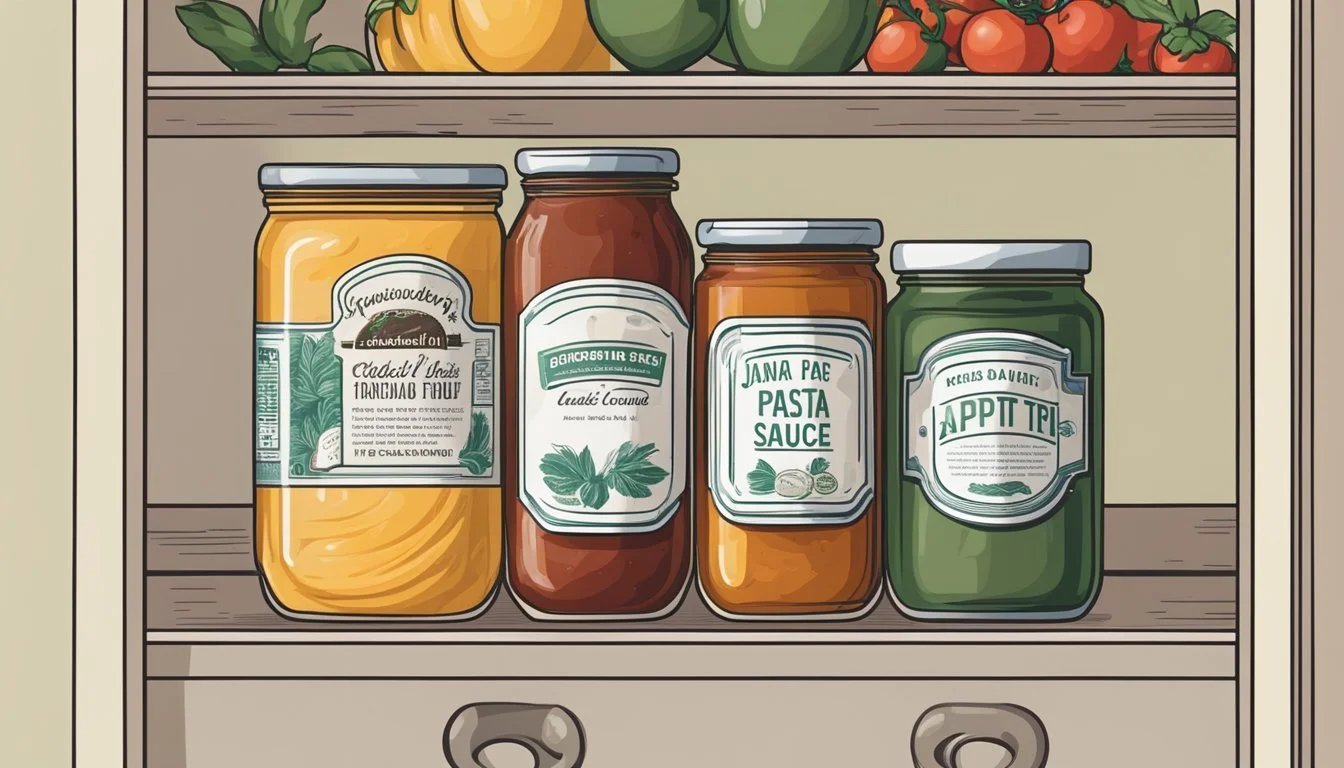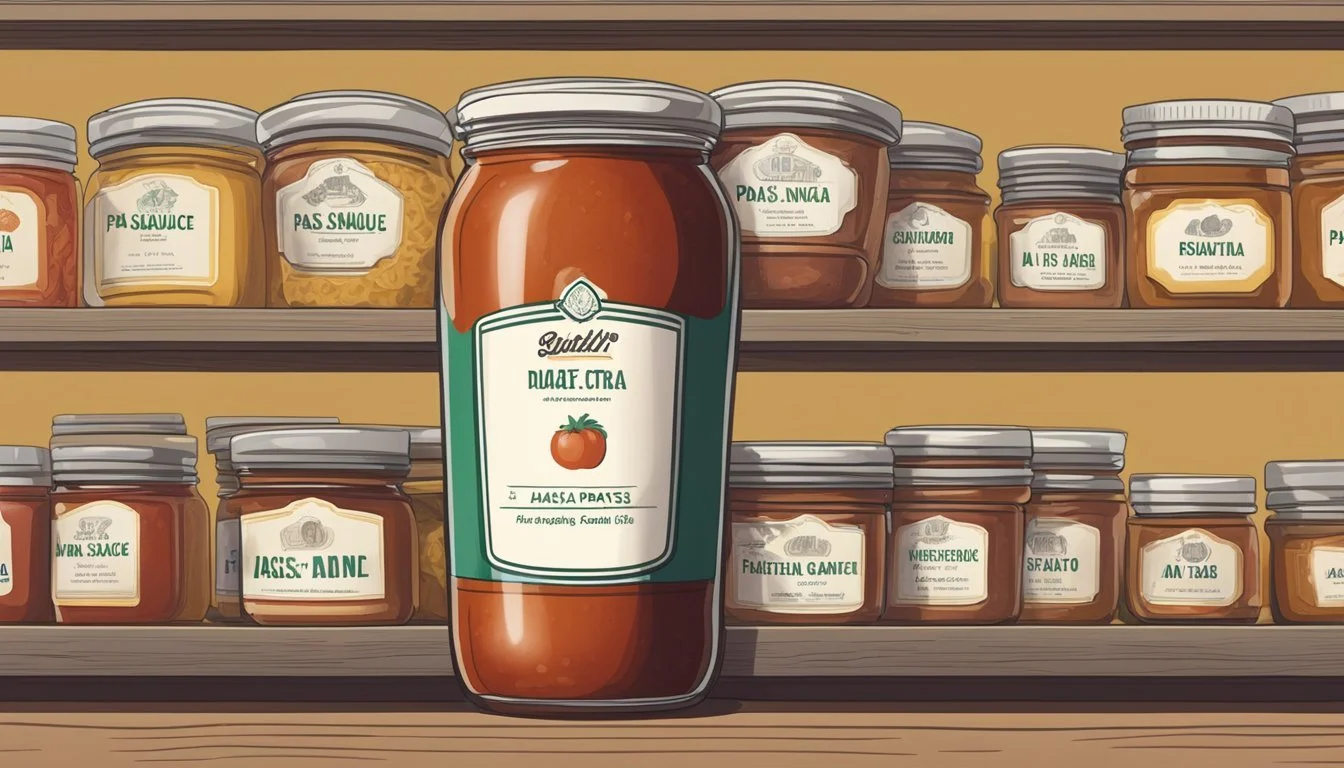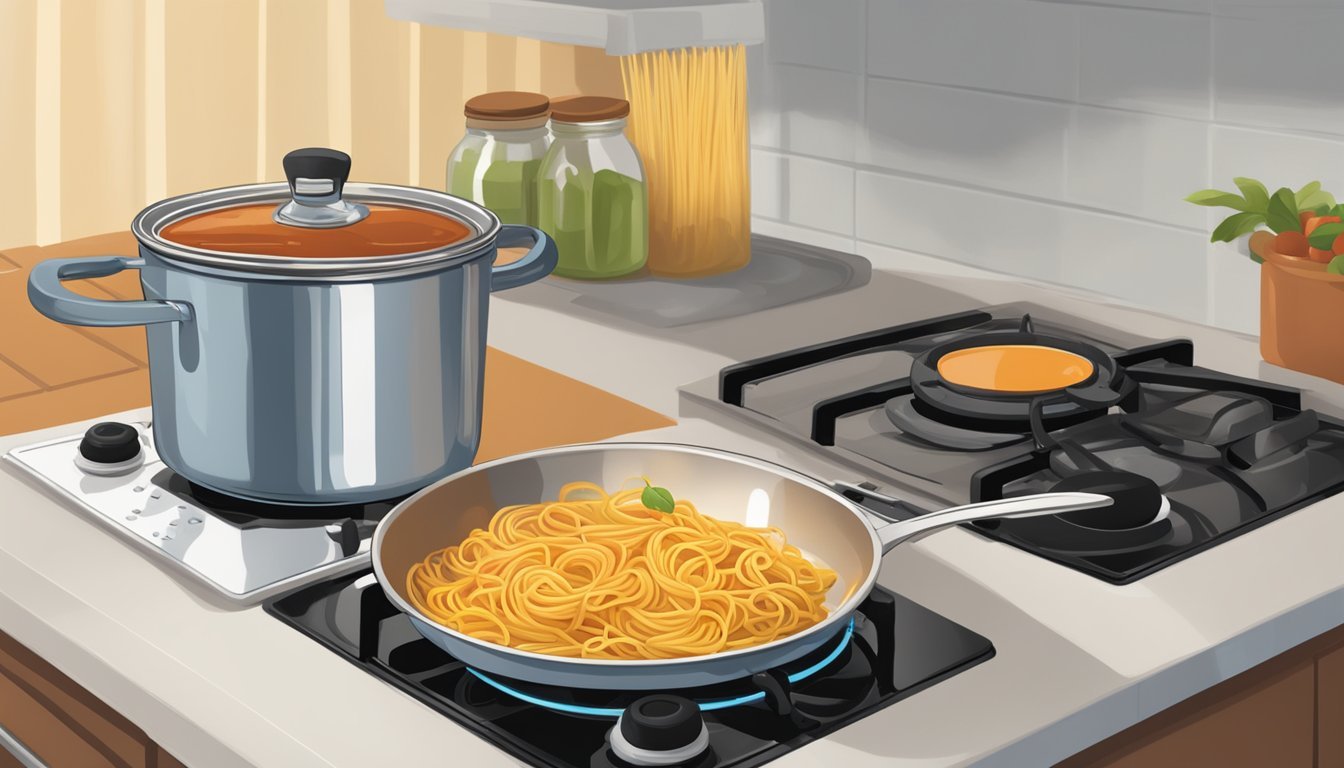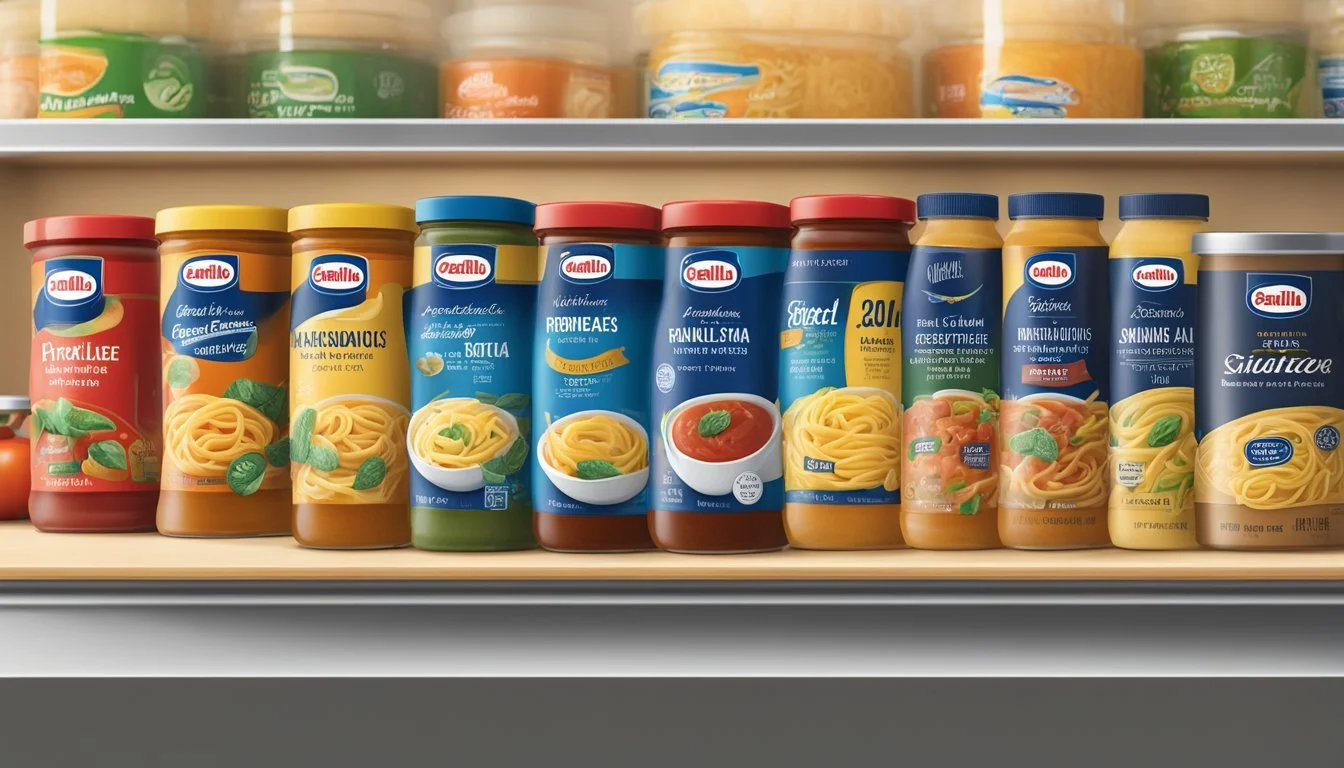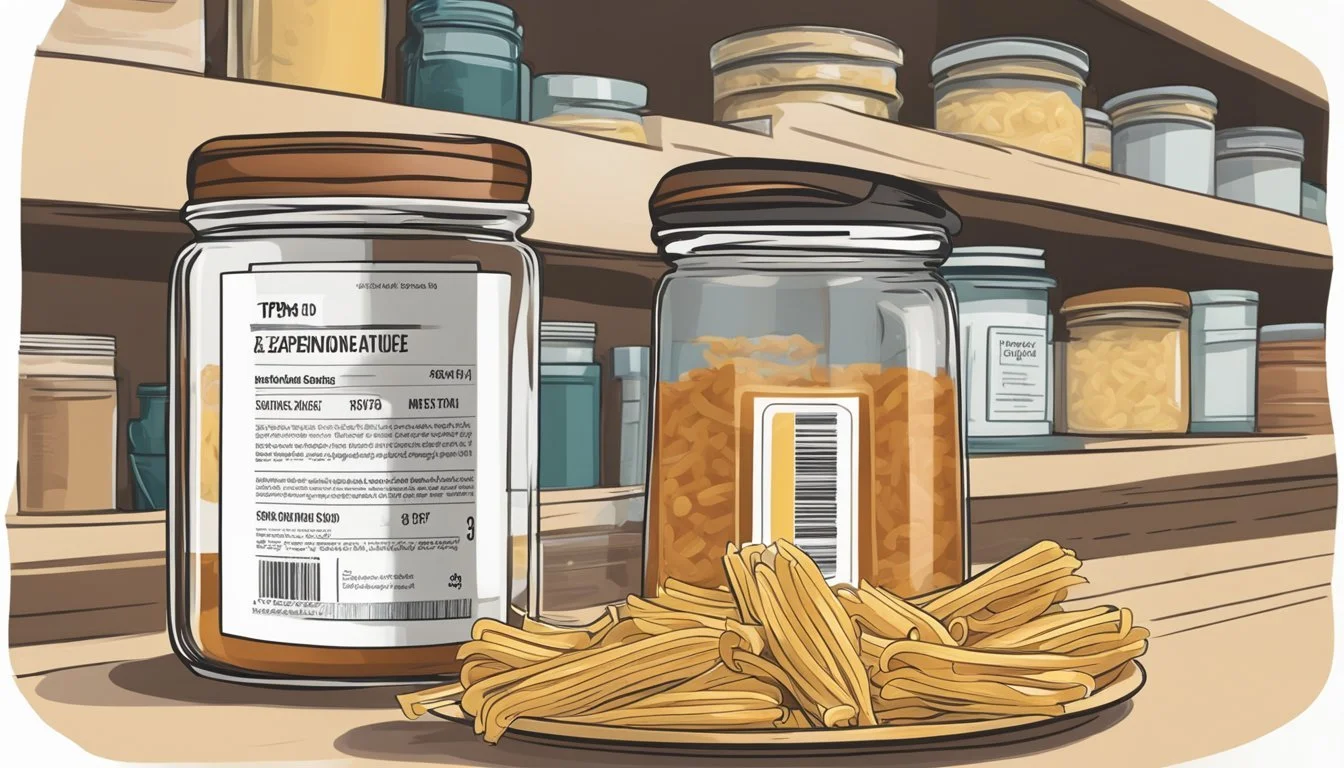How Long Does Pasta Sauce Last?
Shelf Life and Storage Tips
When it comes to preserving the taste and safety of pasta (What wine goes well with pasta?) sauce, understanding its shelf life is crucial. After opening a jar of pasta (how long does pasta last?) sauce, it typically remains safe to consume for 5 to 10 days when stored in the refrigerator at a safe temperature, which is below 40 degrees Fahrenheit. The acidity of tomatoes and the preservatives in commercially produced sauces contribute to this duration, where the cool environment of a fridge slows down bacterial growth that can spoil the food.
While store-bought pasta sauces offer a convenient guideline with their shelf life indicated on the label, homemade pasta sauces may have a slightly shorter refrigerator life due to the absence of commercial preservatives. For those containing dairy, such as Alfredo or other cream-based sauces, the refrigerated shelf life is even shorter, with recommendations suggesting a use within three to four days to ensure both quality and safety.
Regardless of whether the sauce is homemade or purchased, it's important to store pasta sauce properly in a sealed container in the refrigerator to maintain its longevity. Signs of spoilage include an off smell, mold formation, or a change in color, and any sauce exhibiting these should be discarded immediately to prevent the risk of foodborne illness.
Factors Influencing Pasta Sauce Longevity
When considering the shelf life of pasta sauce, they must account for various factors such as storage temperature, ingredient composition, and the type of container used for sealing. These elements dictate how long sauce can maintain its quality and safety for consumption.
Storage Temperature and Conditions
Proper storage temperature is crucial for extending the longevity of pasta sauce. When stored in the refrigerator at or below 40°F (4°C), an opened pasta sauce can last up to 5-10 days. At room temperature, sauces should only be left out for a maximum of two hours, as bacteria grow rapidly between 40°F and 140°F.
Ingredients and Preservatives
The ingredients and preservatives in pasta sauce directly impact how long it will stay fresh. Natural preservatives like salt and citric acid (how long does citric acid last?) can inhibit bacterial growth, while artificial preservatives extend shelf life even further. Pantry or store-bought sauces typically include these preservatives, allowing them to remain unspoiled for months or even years until opened.
Container and Airtight Sealing
An airtight container is essential for retaining the sauce's quality after opening. Transferring pasta sauce to a container with a tight lid can prevent contaminants and reduce oxidation. Whether it's homemade or commercial, ensuring an airtight seal is key to maximizing shelf life in the refrigerator and pantry.
Recognizing Spoilage in Pasta Sauce
Identifying spoilage in pasta sauce can prevent foodborne illness and ensure that the sauce consumed is fresh and safe. Spoilage can be detected through changes in appearance, smell, and texture.
Visual and Textural Changes
Changes in appearance and texture are among the first signs of spoilage in pasta sauce. A sauce that has gone bad may exhibit:
Discoloration: Look for any significant changes in color, such as a sauce turning darker or developing areas of discoloration.
Separation of liquids and solids: A noticeable separation of ingredients, where the water separates from the thicker parts, can indicate spoilage.
Changes in texture: The sauce might become thicker than usual or, conversely, could turn watery and lose its consistency.
Odor and Flavor Assessment
Odor and flavor are critical factors when assessing pasta sauce quality. Spoiled sauce often has a noticeable:
Off odor: A tangy, sour, or otherwise abnormal smell can indicate the presence of dangerous bacteria.
Altered flavor: Any flavors that taste significantly different from when the sauce was fresh are another spoilage indicator.
Mold and Bacteria Growth
Finally, the presence of mold and bacteria growth is a definitive sign of spoilage. Look for:
Visible mold: Fuzzy green, black, or white spots are clear indicators that the sauce should not be consumed.
Bacterial presence: While not always visible, any bulging in the jar or can or any leaks can suggest bacterial activity that may render the sauce unsafe.
Shelf Life of Different Pasta Sauce Types
Understanding the shelf life of pasta sauce is essential for maintaining both its flavor and safety. This section explores how long different types of pasta sauce last, including store-bought jarred sauce, homemade variations, and specialty types like pesto and Alfredo.
Store-Bought Jarred Sauce
Jarred pasta sauce, typically tomato-based, that is purchased from stores has a considerable shelf life due to preservatives. Once opened, it should be refrigerated and can last 5-10 days. Unopened, these sauces can be kept in the pantry for 12-18 months. Storage conditions such as a cool, dry place are ideal for maximizing shelf life.
If you can’t find these ingredients in your local markets, you can order pasta sauce online!
Homemade Sauce Variations
Sauces made at home differ significantly in shelf life because they lack commercial preservatives. A homemade tomato-based sauce should ideally be consumed within 3-4 days when stored in the refrigerator. Incorporation of fresh ingredients like meat, cheese, or vegetables can impact the shelf-life, potentially shortening it due to faster spoilage rates.
Specialty Sauces: Pesto, Alfredo, and Others
Specialty sauces such as pesto and Alfredo, which include fresh herbs, cream, and cheese, have different shelf lives. Pesto can last in the refrigerator for up to a week if it contains a sufficient amount of oil and preservatives. Alfredo and other cream-based sauces should be used within 4-5 days to ensure freshness and to prevent spoilage, as dairy products are more prone to bacterial growth.
Proper Storage Practices for Pasta Sauce
Proper storage practices are crucial for extending the pasta sauce's shelf life and maintaining its quality. This section outlines specific guidelines for refrigeration and freezing, recommends suitable containers, and presents strategies to maximize the sauce's quality over time.
Refrigeration and Freezing Guidelines
Pasta sauce should be refrigerated at 40°F or below immediately after opening to ensure safety and quality. If the sauce will not be used within the recommended time frame, it can be transferred to the freezer for longer storage. Here are the guidelines:
Refrigerator: Store opened pasta sauce in the fridge for 5 to 7 days.
Freezer: Freeze sauce within four days of opening to retain quality. Sauce can be frozen for up to three months.
Container Recommendations
For optimum preservation, use the right type of containers for refrigerating or freezing pasta sauce:
Refrigeration: An air-tight container is ideal for storing pasta sauce in the fridge.
Freezing: For freezing, heavy-duty glass containers, plastic containers, or freezer bags are suitable. Make sure to leave some space at the top as the sauce may expand when frozen.
Streamline your day by having airtight containers delivered to your door with our effortless online checkout.
Maximizing Sauce Quality Over Time
To maintain the best quality of pasta sauce over time, one should ensure it is properly stored. Here are some specifics:
Avoid repeated temperature changes, which can lead to spoilage.
Label containers with the date of storage to keep track of freshness.
Use air-tight containers to minimize exposure to air, which can degrade the quality of the sauce.
Handling and Utilizing Leftover Sauce
When dealing with leftover pasta sauce, one needs to be vigilant about reheating methods and safety measures to ensure the sauce remains palatable and safe to consume.
Reheating Techniques
Reheating leftover sauce requires careful attention for both preserving quality and ensuring food safety. The microwave is commonly used for its convenience and speed. To reheat sauce effectively in the microwave:
Pour the leftover sauce into a microwave-safe container.
Cover the container to prevent splattering, using either a microwave-safe lid or a layer of microwave-safe plastic wrap.
Heat the sauce on medium power, stirring intermittently with a clean spoon to ensure even heating.
Alternatively, one can reheat the sauce on the stovetop:
Transfer sauce to a pot.
Warm over low to medium heat, stirring occasionally.
If necessary, add a small amount of water to prevent the sauce from thickening too much.
Determining Safety for Consumption
Food safety is paramount when it comes to leftovers, and one must recognize when a sauce is no longer safe to eat. Food safety experts suggest using the following guidelines:
Sniff Test: Check for any off odors, an early indicator of spoilage.
Visual Inspection: Look for any signs of mold or unusual changes in color or texture.
Taste Test: Should only be done if the sauce passes both the sniff and visual tests. Even a small taste of spoiled food can be harmful.
Food safety education advises that leftover sauce, properly stored in the refrigerator, should be eaten within three to five days for maximum safety. When in doubt, it is best to err on the side of caution and discard any sauce that may pose a risk.
Expiration and Use-By Dates
When assessing the longevity of unopened pasta sauce, expiration dates or use-by dates on the label are a primary reference. Manufacturers provide these dates as a guide for consumers to understand how long a product is expected to remain at peak quality when unopened and stored properly. Typically, unopened jars of pasta sauce have a shelf life ranging from 12 to 18 months. However, variances in ingredients and preservatives can affect this estimate.
Once the seal on the jar is broken, pasta sauce's freshness diminishes more rapidly. An opened sauce should ideally be used within 5 to 10 days, and it must be stored in the refrigerator to maintain its quality within this timeframe. Here is a concise table summarizing the key points:
State of Pasta Sauce Shelf Life Storage Suggestion Unopened 12 to 18 months Pantry (cool, dark) Opened 5 to 10 days Refrigerator
Consumers should regularly examine their pantry for unopened jars nearing their use-by date and plan to use or discard them accordingly. It's important to note that while the product may still be safe to consume after the expiration date, the quality, such as taste and texture, might not be optimal.
Despite use-by dates being a helpful guide, individual judgment is crucial. One should inspect the sauce for changes in color, smell, or signs of spoilage prior to consumption, especially if it has exceeded the time frame suggested by the label.
Health Risks Associated with Spoiled Sauces
Consuming spoiled pasta sauce can lead to foodborne illness, commonly referred to as food poisoning. Microorganisms such as bacteria, molds, and yeasts can proliferate in sauces that have surpassed their optimum freshness, creating toxins that are harmful when ingested.
One of the primary markers of spoilage is a noticeable change in color, texture, or aroma:
Color: A sauce that has darker spots or discolorations may be undergoing microbial growth.
Texture: If the sauce becomes excessively thick or slimy, spoilage is likely.
Aroma: An off or sour smell is a strong indicator that the sauce should not be consumed.
Food poisoning symptoms can vary but often include:
Nausea
Vomiting
Diarrhea
Abdominal pain
Severe cases may lead to dehydration, which in some cases can become critical if not treated.
To reduce the risk of foodborne illness, individuals should heed expiration dates and storage recommendations. After opening, pasta sauce should typically not be consumed past four days when stored in the refrigerator.
Moreover, the individuals should be cautious of homemade sauces or those with fresh ingredients, as they may lack the preservatives required to prevent premature spoilage and have a shorter shelf life compared to commercial varieties.
It is critical to understand that not all signs of spoilage are visible or detectable by smell or taste. When in doubt, it is safer to dispose of any sauce that may be spoiled to avoid the potential health risks associated with consumption.
Best Practices in Cooking with Pasta Sauce
Optimal use of pasta sauce in cooking can significantly enhance a pasta dish. The key lies in proper preparation, smart cooking techniques, and achieving harmonious flavors that can turn a simple meal into a delightful pasta dinner.
Preparation and Cooking Tips
Before beginning your pasta dish, ensure all ingredients are ready to use. An organized workflow contributes to a more enjoyable cooking experience and better quality meals.
Temperature: Always begin by gently heating pasta sauce, as a sudden introduction to high heat can affect its taste and consistency.
Consistency: If the sauce is too thick, one can thin it with a bit of pasta cooking water.
Herbs and Seasonings: Add fresh herbs towards the end of cooking to preserve their flavor and aroma.
One should cook the pasta al dente, retaining a slight chewiness. This not only provides a better texture but also ensures the pasta continues to absorb flavors from the sauce after being combined.
Creating Complete Pasta Dishes
A well-rounded pasta dinner is about the interplay of pasta, sauce, and additional components. A blend of ingredients should be chosen to compliment and not overpower the pasta sauce.
Fresh ingredients such as garlic, onions, or ripe tomatoes can be sautéed first to form a base for the pasta sauce, enhancing its depth.
Protein choices, whether it’s chicken, seafood, or plant-based options, should be cooked separately and added to the sauce just long enough to marry the flavors.
Cheeses, particularly Parmesan or Pecorino, can be folded in off the heat to add a rich, creamy texture and salty, umami notes.
By following these guidelines, one makes the most of pasta sauces, achieving a perfect balance in pasta dishes that highlight the sauce's quality and the cook's skill.
Freezing and Defrosting Pasta Sauce
When preserving pasta sauce, the freezer can significantly extend its shelf life, while correct defrosting methods ensure the sauce retains its quality and safety upon use.
Effective Freezing Methods
To effectively freeze pasta sauce, one should portion the sauce into usable amounts before freezing. This can be done using ice cube trays or muffin cups for single servings or freezer-safe containers for larger portions. The latter should be filled with room to allow for expansion as the sauce freezes.
Ice Cube Trays: Pour sauce into trays, freeze, and then transfer cubes into freezer bags.
Muffin Cups: Grease cups, fill with sauce, freeze, and store in bags once solid.
Containers: Leave about an inch of headspace to account for expansion.
It's important to label each container or bag with the name and date to track freshness. Pasta sauce can generally be kept frozen for about three months before quality degrades due to freezer burn.
Simplify your life with the convenience of ordering ice cub trays online in just moments.
Thawing Sauce Safely
Thawing pasta sauce should be done with care to maintain safety and flavor. Typically, one can defrost sauce in the refrigerator overnight. For a quicker method, placing the frozen sauce container in cold water can expedite the process, ensuring it remains at a safe temperature.
Refrigerator Thawing:
Transfer the sauce from the freezer to the refrigerator.
Allow it to thaw overnight or at least 12 hours.
Cold Water Thawing:
Keep the sauce in its container or sealed bag.
Submerge in cold water; replace water every 30 minutes.
Continue until fully thawed.
Once thawed, pasta sauce should be reheated for at least 10 to 15 minutes before serving. Thawed pasta sauce can typically last in the refrigerator for 4-5 days. If separation occurs upon thawing, stirring should reintegrate the sauce.
Barilla and Other Branded Sauces
When it comes to storing jarred pasta sauce like Barilla, consumers should note that after opening the jar, the sauce typically maintains quality for 3-5 days in the refrigerator. This recommended span applies uniformly to various sauces under the Barilla label and is a standard timeframe for other branded sauces as well.
For consumers who wish to keep their sauce for a longer period, freezing is a viable option. Sauce stored in a freezer-safe container can last for up to 3 months. This is particularly useful for those who may not use the entire jar within the initial post-opening period.
Shelf life details for these sauces are essential for maintaining both quality and food safety. An unopened jar of Barilla or similar branded pasta sauce can last much longer, usually remaining at peak quality for 12-18 months when stored in a cool, dry place.
State Refrigerator (3-5 days after opening) Freezer (Up to 3 months after opening) Pantry (Unopened) Barilla ✅ ✅ 12-18 months (Peak quality) Other Brands ✅ (May vary slightly) ✅ (May vary slightly) Usually similar to Barilla
Consumers should ensure the sauce cools down before transferring it to any container for refrigeration or freezing. For the best organizational practice, labeling the date on the freezer bag or container can help keep track of the sauce's longevity. This approach aids in preventing waste and serves as a reminder of the sauce's expiration date.
Tips for Avoiding Contamination
When preserving the quality of pasta sauce and extending its shelf life, preventing contamination is crucial. Cleanliness is paramount in safeguarding against harmful pathogens and spoilage microorganisms. The user should start with a clean spoon each time they serve sauce from a jar or container. This simple act helps to prevent the introduction of bacteria from saliva, which can proliferate when transferred to the sauce.
For optimal food safety, one should never consume directly from the jar, as this introduces contaminants that may compromise the sauce's integrity. Instead, portioning the needed amount into a separate dish before consumption is recommended.
Storing pasta sauce in an appropriate container is equally important. An airtight container is ideal for maintaining quality and avoiding contaminants from the environment, such as air, which can introduce additional bacteria or affect the sauce's flavor and texture.
Below is a succinct guide on handling pasta sauce to prevent contamination:
Action Description Use Clean Utensils Always use a clean spoon for each serving to avoid introducing contaminants into the sauce. No Direct Consumption Do not eat from the container to prevent saliva and other potential contaminants from affecting the remaining sauce. Airtight Storage Transfer unused sauce to an airtight container to minimize exposure to air and potential contaminants. Refrigerate Promptly After opening or using, refrigerate the pasta sauce promptly to slow the growth of bacteria.
By adhering to these guidelines, they ensure their pasta sauce remains enjoyable and safe to consume for as long as possible.
Determining the Lifespan of Pasta Sauces
The shelf life of pasta sauces varies depending on several factors including whether the sauce is homemade or commercially jarred, the ingredients used, and the storage conditions.
Commercially Jarred Pasta Sauce: Once opened, a jar of commercially prepared pasta sauce typically lasts in the refrigerator for 4 to 10 days. This range depends on the brand and the specific preservatives used within the sauce. Left unopened, these jars can maintain quality for 12 to 18 months when stored in a cool, dry place.
Homemade Spaghetti Sauce: Homemade spaghetti sauce, made fresh without preservatives, generally has a shorter refrigerator lifespan of approximately 3 to 4 days. It's important to refrigerate homemade sauces as soon as they cool to maintain safety and quality.
Sauce Lifespan Breakdown:
Opened Jarred Sauce: 4-10 days in fridge
Unopened Jarred Sauce: 12-18 months in pantry
Homemade Sauce: 3-4 days in fridge
To determine a sauce's viability, one should check not only the date but also the scent and appearance. If a sauce emits an off odor, develops mold, or changes in texture, it should be discarded, regardless of its age. Neutral handling and regular inspections will maximize a sauce's lifespan and ensure it remains a safe addition to various dishes.

